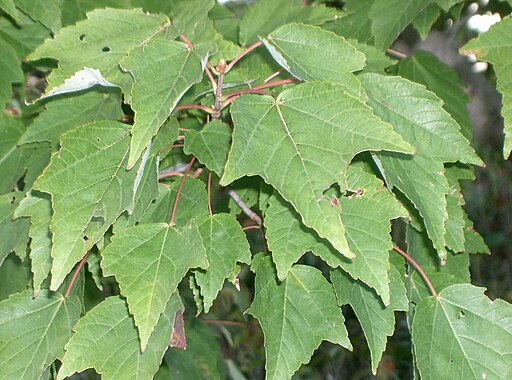Classification System: APG IV
Superregnum: Eukaryota
Regnum: Plantae
Cladus: Angiosperms
Cladus: Eudicots
Cladus: Core eudicots
Cladus: Rosids
Cladus: Eurosids II
Ordo: Sapindales
Familia: Sapindaceae
Subfamilia: Hippocastanoideae
Tribus: Acereae
Genus: Acer
Section: Acer sect. Rubra
Species: Acer pycnanthum
Name
Acer pycnanthum K.Koch in Miq., Ann. Mus. Bot. Lugduno-Batavi 1: 250 (1864)
Typus: Keiske ITOO s.n. (cf. L 0170910, without type indication).
Type locality: Iaponia[Japan]. Probabiliter regio borealis.
Synonyms
Homotypic
Acer rubrum var. pycnanthum (K.Koch) Makino, Bot. Mag. (Tokyo) 26: 148 (1912)
Distribution
Native distribution areas:
Asia-Temperate
Eastern Asia
Japan [Honshu].
References: Brummitt, R.K. 2001. TDWG – World Geographical Scheme for Recording Plant Distributions, 2nd Edition
References
Primary references
Miquel, F.A.W. 1863–1864. Annales Musei Botanici Lugduno-Batavi. Vol. 1. 331 pp, 84 tab. Amsterdam. BHL Reference page.
Additional references
Makino, T. 1912. Observations on the Flora of Japan. (Continued from p. 122) The Botanical Magazine [Tokyo] 26(305): 144–158. DOI: 10.15281/jplantres1887.26.305_144 Open access Reference page.
Ohwi, J. 1965. Flora of Japan (translated by F.G. Meyer & E.M. Walker). 1067 pp. Smithsonian Institution, Washington, D.C. BHL Reference page.
Murray, A.E., 1970. A monograph of the Aceraceae. Unpublished Ph.D. dissertation, The Pennsylvania State University. Reference page.
Gelderen, D.M. van, Jong, P.C.de & Oterdoom, H.J. 1994. Maples of the world. Timber Press, Portland, Or., 458 pp. ISBN 0-88192-000-2. Reference page.
Govaerts, R.H.A. 1995. World Checklist of Seed Plants 1(1, 2). 483, 529 pp. MIM, Deurne. ISBN 90-341-0852-X (issue 1) ISBN 90-341-0853-8 (issue 2). Reference page.
Iwatsuki, K., Boufford, D.E. & Ohba, H. (eds.) 1999. Flora of Japan IIc. Angiospermae, Dicotyledoneae, Archichlamydeae(c). 328 pp., Kodansha Ltd., Tokyo. ISBN 978-4-06-154606-6 Reference page.
Links
Govaerts, R. et al. 2021. Acer pycnanthum in Kew Science Plants of the World online. The Board of Trustees of the Royal Botanic Gardens, Kew. Published online. Accessed: 2021 December 30. Reference page.
Hassler, M. 2021. Acer pycnanthum. World Plants: Synonymic Checklists of the Vascular Plants of the World In: Roskovh, Y., Abucay, L., Orrell, T., Nicolson, D., Bailly, N., Kirk, P., Bourgoin, T., DeWalt, R.E., Decock, W., De Wever, A., Nieukerken, E. van, Zarucchi, J. & Penev, L., eds. 2021. Species 2000 & ITIS Catalogue of Life. Published online. Accessed: 2021 December 30. Reference page.
International Plant Names Index. 2021. Acer pycnanthum. Published online. Accessed: 30 December 2021.
IUCN: Acer pycanthum K.Koch (Vulnerable)
Tropicos.org 2021. Acer pycnanthum. Missouri Botanical Garden. Published online. Accessed: 30 December 2021.
USDA, ARS, Germplasm Resources Information Network. Acer pycnanthum in the Germplasm Resources Information Network (GRIN), U.S. Department of Agriculture Agricultural Research Service. Accessed: 30 December 2021.
Vernacular names
English: Hananoki Maple
日本語: ハナノキ
Acer pycnanthum, the Japanese red maple, (ハナノキ, hananoki, or 花の木, hanakaede, meaning "flower maple") is a species of maple native to Japan, and introduced to Korea.[3] A tree usually about 20 m, reaching 30 m, it prefers to grow in relict mountain wetlands. It flowers in April, prior to the emergence of leaves.[4] Although considered Vulnerable in its native habitat, it has found some use as a street tree, and is the official tree of a number of Japanese municipalities and of Aichi Prefecture.[1]
Acer pycnanthum is dioecious, with separate male and female flowers.[5] The bark is grey and longitudinally fissured, sometimes giving a shaggy appearance.[6] The leaves, which emerge a bronze-green color in the spring, are shallowly lobed and have a whitish bloom on the underside. They turn yellow, orange, red, and purple in the autumn.[7] It is similar to the smaller Acer rubrum.[8]
A. pycanthum is suitable for USDA hardiness zone 5.[6] It prefers full sun to partial shade and is hardy in all of the UK and northern Europe.[7] Common problems include aphids and verticillium wilt.[8]
Spring flowers and leaf buds
References
Harvey-Brown, Y. (2020). "Acer pycnanthum". IUCN Red List of Threatened Species. 2020: e.T193858A2286832. doi:10.2305/IUCN.UK.2020-1.RLTS.T193858A2286832.en. Retrieved 20 November 2021.
Ann. Mus. Bot. Lugduno-Batavi 1: 250 (1864)
"Acer pycnanthum K.Koch". Plants of the World Online. Board of Trustees of the Royal Botanic Gardens, Kew. 2017. Retrieved 17 September 2020.
Saeki, Ikuyo (2011). "709. Acer pycnanthum". Curtis's Botanical Magazine. 28 (2): 141–153. doi:10.1111/j.1467-8748.2011.01738.x.
Renner, S. S.; Beenken, L.; Grimm, G. W.; Kocyan, A.; Ricklefs, R. E. (2007). "The Evolution of Dioecy, Heterodichogamy, and Labile Sex Expression in Acer". Evolution. 61 (11): 2701–2719. doi:10.1111/j.1558-5646.2007.00221.x. PMID 17894810. S2CID 1940661.
"Acer pycnanthum - Trees and Shrubs Online". treesandshrubsonline.org. Retrieved 2021-03-23.
"Acer pycnanthum | Japanese red maple/RHS Gardening". www.rhs.org.uk. Retrieved 2021-03-23.
"Japanese Red Maple (Acer pycnanthum) - Plants | Candide Gardening". Candide. Retrieved 2021-03-23.
Retrieved from "http://en.wikipedia.org/"
All text is available under the terms of the GNU Free Documentation License


